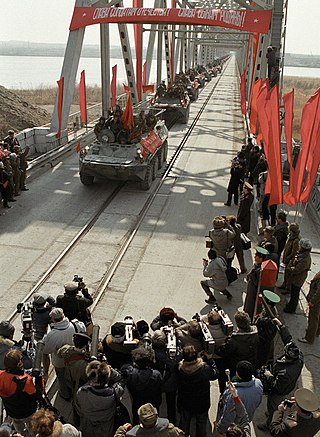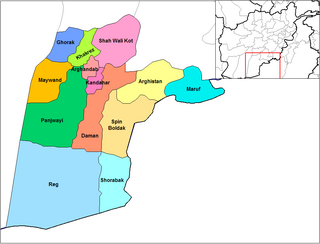
Mohammad Najibullah Ahmadzai, commonly known as Dr. Najib, was an Afghan politician who served as the General Secretary of the People's Democratic Party of Afghanistan, the leader of the one-party ruling Republic of Afghanistan from 1986 to 1992 and as well as the President of Afghanistan from 1987 until his resignation in April 1992, shortly after which the mujahideen took over Kabul. After a failed attempt to flee to India, Najibullah remained in Kabul. He lived in the United Nations headquarters until his assassination during the Taliban's capture of Kabul.

The Democratic Republic of Afghanistan (DRA), renamed the Republic of Afghanistan in 1987, was the Afghan state during the one-party rule of the People's Democratic Party of Afghanistan (PDPA) from 1978 to 1992. It relied heavily on assistance from the Soviet Union for most of its existence, especially during the Soviet–Afghan War.

The Soviet–Afghan War was a protracted armed conflict fought in the Soviet-controlled Democratic Republic of Afghanistan (DRA) from 1979 to 1989. The war was a major conflict of the Cold War as it saw extensive fighting between the DRA, the Soviet Union and allied paramilitary groups against the Afghan mujahideen and their allied foreign fighters. While the mujahideen were backed by various countries and organizations, the majority of their support came from Pakistan, the United States, the United Kingdom, China, Iran, and the Arab states of the Persian Gulf. The involvement of the foreign powers made the war a proxy war between the United States and the Soviet Union. Combat took place throughout the 1980s, mostly in the Afghan countryside. The war resulted in the deaths of approximately 3,000,000 Afghans, while millions more fled from the country as refugees; most externally displaced Afghans sought refuge in Pakistan and in Iran. Approximately 6.5% to 11.5% of Afghanistan's erstwhile population of 13.5 million people is estimated to have been killed over the course of the conflict. The Soviet–Afghan War caused grave destruction throughout Afghanistan and has also been cited by scholars as a significant factor that contributed to the dissolution of the Soviet Union, formally ending the Cold War.

Sibghatullah Mojaddedi was an Afghan politician, who served as Acting President after the fall of Mohammad Najibullah's government in April 1992. He was the first leader to call for armed resistance against the Soviet-backed regime in 1979 and founded the Afghan National Liberation Front at the time; later becoming a respected figure among the various Afghan mujahideen. He served as the chairman of the 2003 loya jirga that approved Afghanistan's new constitution. In 2005, he was appointed chairman of the Meshrano Jirga, upper house of the National Assembly of Afghanistan, and was reappointed as a member in 2011. He also served on the Afghan High Peace Council. Mojaddedi is considered to have been a moderate Muslim leader.

The 1989–1992 Afghan Civil War, also known as the FirstAfghan Civil War, took place between the Soviet withdrawal from Afghanistan and the end of the Soviet–Afghan War on 15 February 1989 until 27 April 1992, ending the day after the proclamation of the Peshawar Accords proclaiming a new interim Afghan government which was supposed to start serving on 28 April 1992.
Operation Magistral was a Soviet Army military operation during the Soviet–Afghan War that began in late November 1987 and ended in early January 1988.

The Panjshir offensives were a series of battles from 1980 to 1985 between the Soviet Army and groups of Afghan mujahideen under Ahmad Shah Massoud. The goal of these offensives was control of the strategic Panjshir Valley in Afghanistan, during the Soviet–Afghan War of the 1980s.
The Battles of Zhawar were fought during the Soviet–Afghan War between Soviet Army units, and their allies of the Democratic Republic of Afghanistan against Afghan mujahideen groups. The Soviets' objective was to destroy the Mujahideen logistic base situated at Zhawar, 3 kilometers from the Pakistani border.

Pursuant to the Geneva Accords of 14 April 1988, the Soviet Union conducted a total military withdrawal from Afghanistan between 15 May 1988 and 15 February 1989. Headed by the Soviet military officer Boris Gromov, the retreat of the 40th Army into the Union Republics of Central Asia formally brought the Soviet–Afghan War to a close after nearly a decade of fighting. It marked a significant development in the Afghan conflict, having served as the precursor event to the First Afghan Civil War.
Operation Ghashey was a military offensive launched by Mujahideen forces against positions held by the army of the Republic of Afghanistan between October 23 and November 7, 1988. The aim of the operation was to seize and hold a portion of the Kabul–Jalalabad highway for a short period of time, an action that was aimed at weakening the hold of the Afghan government over Jalalabad.
The Badaber uprising was an armed rebellion by Soviet and Afghan prisoners of war who were being held at the Badaber fortress near Peshawar, Pakistan. The prisoners fought the Afghan Mujahideen of the Jamiat-e Islami party in an attempt to escape.

The Battle of Arghandab was an offensive launched by Afghan government forces, supported by Soviet troops, against mujahideen strongholds in the Arghandab District of Kandahar Province, Afghanistan, in 1987. The operation ended in failure, and the government forces withdrew after suffering heavy losses.

The siege of Urgun was a military engagement that took place during the Soviet–Afghan War. Between August 1983 and January 1984 Mujahideen forces laid siege to the town of Urgun, which was defended by a garrison of troops loyal to the Democratic Republic of Afghanistan. The mujahideen tried to take the town by storm using tanks, but despite making initial progress, they were eventually driven back and the siege was lifted.
The Revolutionary Council of Islamic Unity of Afghanistan was a Hazara political movement which appeared in Afghanistan in 1979 in opposition to the increasingly leftist Kabul government. The movement was led by Sayyid Ali Beheshti.
The Sharafat Kuh Front was an Afghan mujahideen group active in the 1980s in Farah Province. It was led by Mulawi Mohammad Shah, an Achakzai Pashtun.

Amin Wardak is a major Afghan mujahideen leader who mostly fought against the Afghan communist regime and the Soviet invaders in his home region of Wardak Province during the Soviet–Afghan War in the 1980s. However, his reach of military actions had spread till the provinces of Ghazni and Kabul, and his political influence and relations towards the other mujahideen groups was reaching even further.
Lor Koh is a mountain, 2,492 metres high, southeast of the city of Farah in western Afghanistan.
The FirstBattle of Zhawar was fought during the Soviet–Afghan War between Afghan Army units, and their allies the Soviet Union, against mujahideen groups of Haqqani and Khalis. Their objective was to destroy the Mujahideen logistic base situated at Zhawar, 3 kilometers from the Durand line.
The Second Battle of Zhawar was a significant engagement that took place during the Soviet-Afghan War. It pitted Afghan Army units, supported by the Soviet Union, against mujahideen faction led by Jalaluddin Haqqani. The objective of the battle was to destroy the mujahideen's logistical base located in Zhawar, just three kilometers from the Durand Line.










